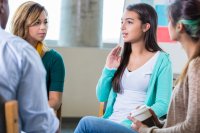A Proactive Approach to Discipline
Restorative discipline seeks to create an environment in which problem behavior is less likely to occur.
Educators who’ve had success with restorative practices find them to be much more than an alternative to suspension. Restorative practices encourage us to engage with our students not only when there’s an incident but throughout the school day. They’re part of a system of discipline that takes us back to the root of that word, the Latin disciplina, meaning instruction and knowledge. They draw on what we as teachers do naturally—teach.
Restorative discipline, then, is proactive and supportive as much as it is responsive. It aims to create conditions in which issues are less likely to arise, and in which, when they do arise, we have the connections and skills needed to handle them and restore the community as needed.
What does it take to adopt an approach to discipline that is proactive and supportive as well as responsive to problems in school? There are several key steps.
Steps to Proactive Discipline
Get to know your students: For both teachers and students to be our best selves, we must get to know each other. Teaching and learning occur through relationships. The stronger the relationship and the better we understand our students, the more knowledge and goodwill we have to draw on when the going gets tough.
Share and teach into classroom expectations: We want to make sure our students know and understand our classroom expectations. Discussing them early on promotes buy-in and allows us to better assess what skills and support students need to live up to our expectations.
Develop classroom norms collaboratively: There is a power in deciding together which norms you and your students need to do your best work. Once you’ve come up with a manageable list, spend some time exploring it. For example, what does respect look, feel, and sound like? Which norms will be easy to follow, and which more challenging? Why? Spend some time problem-solving the more challenging norms, and consider together how you might support one another when challenges arise.
Steps to Supportive and Responsive Discipline
Model kind, supportive, and respectful behavior: Having come up with a list of classroom norms, it’s important that you, as the adult, lead the way and show students how to uphold them consistently.
Review classroom norms and expectations: Be sure to provide reminders about your norms, especially early on. Learning happens over time, and most students need reminders. While standing at the door to welcome your students to class, for example, you might urge them to change putdowns you observed in the hall into kind, supportive language. Remind them of the discussion you had around respect early in the year.
Redirect student behavior using positive language: Such direction can help students get back on track. To a student who’s off task: “I need you to go to page 35, read the first paragraph, and then turn to the questions at the bottom of the page.” To a student who’s disrespectful: “You seem frustrated. I’d be happy to sit with you and problem-solve. Let me know when you’re ready.”
Recognize student effort and growth: Noticing that a student is trying or is making some headway is important—this growth deserves to be celebrated. If a student has trouble focusing for the duration of class, going from five minutes of focused work in September to 10 minutes in October is progress that should be recognized even as we encourage the student to make it to 15 minutes in November.
Signal nonverbal support, recognition, or redirection: If you’ve built a problem-solving relationship with students, you may be able to use proximity or prearranged signals to help a student get back on track or to encourage them, all without saying a word.
Check in and offer gestures of support: Young people in our care often complain about not being seen or heard by adults, especially in middle and high school, which can be lonely, impersonal places. Notice if a student seems troubled. Check in with them: “Are you OK?” or “You look upset—do you need a few minutes to collect yourself in the hallway?” This sends a message that you care, that you see the student and are interested in their well-being.
Have a restorative chat: A one-on-one chat in which you actively listen can help you better understand a student who’s struggling with behavior. Active listening has the additional benefit of helping people calm down, which can encourage them to be more introspective and open to problem-solving.
Imagine a student who spills into class several minutes after the bell, disrupting your lesson. Consider asking if they’re OK. Welcome them to class and direct them to quietly take their seat. When you have a few minutes, pull up a chair. Ask them what happened—why were they late? Express concern about what happened or about this becoming a habit. Have the student reflect on the effects of being late and problem-solve getting to class on time.
The goal of these disciplinary interventions is to teach into behavior while building and maintaining our relationships with students and strengthening the community as a whole. When more serious problems arise or harm is done, we can then draw on the relationships and skills we’ve built to come to a resolution and repair the harm. Meanwhile, our work has had the positive effects of supporting students’ social and emotional growth and creating a more congenial and productive classroom climate.
